The Taiwan-US tariff negotiations are coming to an end. The US media Politico quoted people familiar with the matter today as saying that the US requires Taiwan to invest "between US$350 billion in South Korea and US$550 billion in Japan",...

The Taiwan-US tariff negotiations are coming to an end. The US media Politico quoted people familiar with the matter today as saying that the US requires Taiwan to invest "between US$350 billion in South Korea and US$550 billion in Japan", and Taiwan aims to finalize an agreement with the US before the end of the month.
In July, it was reported that Taiwan’s government intends to increase its investment in the United States by 300 billion (approximately NT$9.32 trillion) to US$400 billion in order to obtain the best tariffs.
On the 11th, President Lai Ching-te described the reciprocal tariff negotiations between Taiwan and the United States as "missing a final step." The current temporary tariff is 20%, and the goal is to reduce the tax rate without overlapping. The United States also hopes to obtain most-favored nation status when it launches a "Section 232" investigation on semiconductor imports.
Politico, a US political news website, today quoted "people familiar with the Taiwan-US tariff negotiations and authorized to speak anonymously" as saying that if the US government shutdown can be ended as soon as possible, Taiwan hopes to finalize a tariff agreement before the end of this month.
Even if the Supreme Court may overturn U.S. President Trump’s reciprocal tariffs, Politico reported that Taiwan continues to push for a tariff trade agreement with the United States because it is more concerned that the ongoing “Section 232” investigation by the U.S. Department of Commerce may impose new tariffs on Taiwan’s globally dominant semiconductor industry.
Reports indicate that the Trump administration is currently negotiating with Taiwan on a clause in the tariff agreement that requires Taiwan to invest billions of dollars in the United States. This arrangement is modeled on similar commitments reached by the US government with South Korea and Japan.
Informed sources pointed out that the scale of this investment will be "between South Korea's US$350 billion and Japan's US$550 billion."
After Vice President of the Executive Yuan Chung Li-jun visited the United States in early October, she held a press conference to explain the expansion of investment in the United States. She pointed out that she has proposed to the United States a "Taiwan model" that is different from Japan and South Korea. It will use independent planning by enterprises, coupled with government financial credit insurance, and jointly develop industrial clusters through government-to-government cooperation.
In response to reports that the Supreme Court may overturn Trump's tariffs, Representative Yu Da'ao in the United States responded to relevant questions at a Taiwan overseas Chinese dinner on the 8th. He said that the Supreme Court's ruling and the Taiwan-US tariff negotiations should be looked at separately, and we cannot expect the court's ruling. Both Taiwan and the United States hope to complete the negotiations as soon as possible, and the results are just around the corner, but in the end, bilateral agreement is still required.
Politico’s report also said that as the Supreme Court rules to weigh the limits of Trump’s tariff powers, foreign countries are expected to accelerate progress in negotiations with the U.S. government, judging that if the Supreme Court rules that Trump’s tariff policies are invalid, it may weaken the U.S. government’s negotiating power, giving smaller economies a greater chance to dominate future tariff agreements.
An official from a small European country said anonymously, "The door is open and we plan to wait for the opportunity."
No matter what the Supreme Court ultimately decides, the official pointed out that all countries that have not yet reached a trade agreement with the White House are under pressure to pursue "the most favorable outcome compared with other countries that have reached agreements to reduce tariffs."
The U.S. Supreme Court debated the legality of Trump's use of emergency powers to impose reciprocal tariffs last week. The justices, both conservative and liberal, questioned Trump's approach. However, even if the tariffs are eventually overturned, Trump will still have other legal tools to impose different tariffs based on other legal sources such as the Trade Expansion Act of 1962.